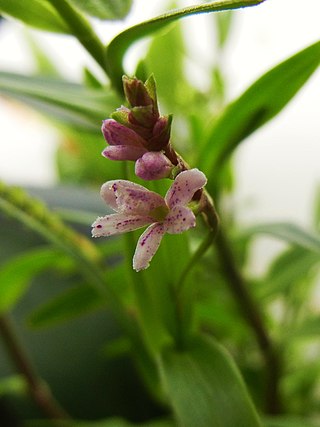
Cypripedioideae is a subfamily of orchids commonly known as lady's slipper orchids, lady slipper orchids or slipper orchids. Cypripedioideae includes the genera Cypripedium, Mexipedium, Paphiopedilum, Phragmipedium and Selenipedium. They are characterised by the slipper-shaped pouches of the flowers – the pouch traps insects so they are forced to climb up past the staminode, behind which they collect or deposit pollinia, thus fertilizing the flower. There are approximately 165 species in the subfamily.

Phragmipedium is a genus of the Orchid family (Orchidaceae) and the only genus comprised in the tribe Phragmipedieae and subtribe Phragmipediinae. The name of the genus is derived from the Greek phragma, which means "division", and pedium, which means "slipper". It is abbreviated 'Phrag' in trade journals.

Grammatophyllum speciosum, also called giant orchid, tiger orchid, sugar cane orchid or queen of the orchids, is a species of orchid native to Laos, Myanmar, Thailand, Vietnam, Borneo, Indonesia and Malaysia. It has also been recorded in the Philippines, New Guinea and the Solomon Islands. It is listed by the Guinness Book of World Records as the world's tallest orchid, with specimens recorded up to 7.62 metres (25 ft) in height.

Phragmipedium kovachii is an orchid species found to be new to science in 2001, native to the Andean cloud forests of northern Peru. A species with terrestrial habit and growing in clumps of several individuals, it displays showy pink to purple flowers up to 20 cm (8 in) wide. It is currently considered a critically endangered species by the IUCN, due to overcollection in the wild.

Afrocarpus falcatus is a species of tree in the family Podocarpaceae. It is native to the montane forests of southern Africa, where it is distributed in Malawi, Mozambique, South Africa, and Eswatini. Common names include common yellowwood, bastard yellowwood, outeniqua yellowwood, African pine tree, weeping yew, Afrikaans: outeniekwageelhout, kalander, Sotho: mogôbagôba, Xhosa: umkhoba and Zulu: umsonti. It is widespread, in some areas abundant, and not considered threatened, but it is a protected tree in South Africa. It is grown as an ornamental tree, especially in South Africa, and occasionally abroad.

The red-legged pademelon is a species of small macropod found on the northeastern coast of Australia and in New Guinea. In Australia it has a scattered distribution from the tip of Cape York Peninsula in Queensland to around Tamworth in New South Wales. In New Guinea it is found in south central lowlands.
Guibourtia ehie is an evergreen tree of the genus Guibourtia in the family Fabaceae, also known by the common names amazique, amazoué, hyedua, black hyedua, mozambique, ovangkol and shedua.

The plantain squirrel, oriental squirrel or tricoloured squirrel is a species of rodent in the family Sciuridae found in Indonesia, Malaysia, Singapore, and Thailand in a wide range of habitats: forests, mangroves, parks, gardens, and agricultural areas. Fruit farmers consider them to be pests.

Alstonia macrophylla, the hard alstonia, hard milkwood or big-leaved macrophyllum, is a species of plant in the family Apocynaceae.

Phalaenopsis micholitzii is a species of plant in the family Orchidaceae. It is endemic to the Zamboanga peninsula in the island of Mindanao, Philippines.

Phragmipedium schlimii is a species of orchid endemic to Colombia.

Epidendrum catillus is an epiphytic orchid native to Colombia, Ecuador and Peru at altitudes ranging from 0.8 km to 1.6 km.
Epidendrum cochlidium is a neotropical orchid which can grow both terrestrially and epiphytically in Peru and Venezuela at altitudes ranging from 1.2 km to 2.9 km.

Epidendrum fimbriatum is a terrestrial orchid native to high altitudes (2.2—3.4 km) in Bolivia, Colombia, Ecuador, Peru, and Venezuela.

Cypripedium calceolus is a lady's-slipper orchid, and the type species of the genus Cypripedium. It is native to Europe and Asia.

Phaius tankervilleaevar.australis, also known as the common swamp orchid, southern swamp-orchid, swamp lily or island swamp-orchid, is a species of orchid endemic to eastern Australia. It is an evergreen, terrestrial herb with large, crowded pseudobulbs, large pleated leaves and flowers that are reddish brown on the inside and white outside.

Amanita crocea, the saffron ringless amanita, is a species of Amanita widely distributed in Europe.

Boerhavia erecta, commonly known as the erect spiderling or the erect boerhavia, is one of more than 100 species in the genus Boerhavia L. Boerhavia erecta is native to the United States, Mexico, Central America and western South America, but now is cosmopolitan in tropical and subtropical regions. In Africa its distribution extends from West Africa, eastwards to Somalia and down to South Africa. It has recently been found in parts of Madagascar and Réunion. In Asia, it occurs in India, Java, Malaysia, the Philippines, China and the Ryukyu Islands.

Leucostele terscheckii, commonly known as the cardon grande cactus or Argentine saguaro, is a large cactus native to South America and popular in cultivation.

Encephalartos lebomboensis is a species of cycad in the family Zamiaceae. Native to the Lebombo Mountains of South Africa, the species was first described in 1949 by the South African botanist Inez Verdoorn. It is commonly known as the Lebombo cycad, although the name is also used for Encephalartos senticosus which also occurs in the same locality.




















